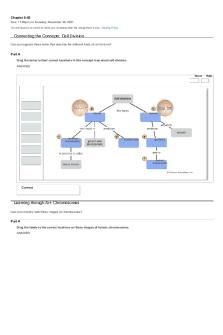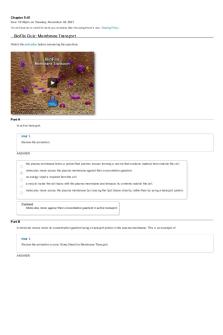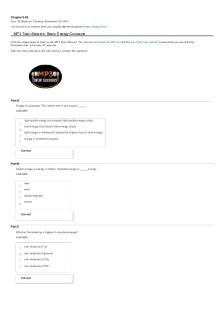Chapter 10-03 - Pearson Homework PDF

| Title | Chapter 10-03 - Pearson Homework |
|---|---|
| Course | Biological Principles For Non-Majors |
| Institution | Broward College |
| Pages | 8 |
| File Size | 477 KB |
| File Type | |
| Total Downloads | 75 |
| Total Views | 153 |
Summary
Pearson Homework...
Description
Chapter 10-03 Due: 11:59pm on Tuesday, November 30, 2021 You will receive no credit for items you complete after the assignment is due. Grading Policy
Building Vocabulary: Viruses Can you match each term that relates to viruses with its description?
Part A Drag the terms on the left to the appropriate blanks on the right to complete the sentences. ANSWER:
Reset
1. Although generally not considered to be alive, a virus
Help
is studied alongside other microbes such
as bacteria. 2. The lytic cycle
3. A prophage
is a viral life cycle that results in bursting of the host cell.
is a viral genome that has inserted itself into the genome of its host.
4. The lysogenic cycle
is a viral life cycle in which the virus inserts its genome into the genome of
its host, where it may remain dormant for long periods. 5. A bacteriophage
Correct
Activity: Phage Lytic Cycle
Click here to complete this activity. Then answer the questions.
Part A The lytic cycle of bacteriophage infection ends with the _____. ANSWER:
is a virus that specifically infects bacteria.
replication of viral DNA entry of the phage protein coat into the host cell assembly of viral particles into phages the injection of phage DNA into a bacterium rupture of the bacterium
Correct The bacterium ruptures and phages are released.
Part B The pointer is indicating the _____.
ANSWER: viral envelope viral nucleic acid genome bacterium's nucleic acid genome viral protein coat bacterium's plasma membrane
Correct The viral protein coat surrounds its genome.
Part C As a result of the lytic cycle, _____. ANSWER:
the host cell is not destroyed the host cell's DNA is destroyed viral ribosomes are produced viral DNA is incorporated into host cell DNA a prophage is created
Correct The host cell's DNA is destroyed, and ultimately, the host cell itself is destroyed in the lytic cycle.
Activity: Phage Lysogenic and Lytic Cycles
Click here to complete this activity. Then answer the questions.
Part A In the lysogenic cycle _____. ANSWER:
host DNA is destroyed and viral DNA is replicated a bacterium replicates without passing viral DNA to its daughter cells viral DNA is destroyed and host DNA is replicated a bacterium divides once before the lytic cycle is initiated viral DNA is replicated along with host DNA
Correct Viral DNA, incorporated into host DNA as a prophage, is replicated along with host DNA.
Part B Cycle A is the _____ cycle and cycle B is the _____ cycle.
ANSWER:
lytic ... lysogenic lytic ... phage lysogenic ... phage lysogenic ... lytic phage ... lysogenic
Correct The lytic cycle concludes with rupture of the host cell. The lysogenic cycle involves replication of viral DNA along with replication of the host.
Activity: Retrovirus (HIV) Reproductive Cycle
Click here to complete this activity. Then answer the questions.
Part A The genetic material of HIV consists of _____. ANSWER: single-stranded DNA single-stranded RNA double-stranded DNA double-stranded RNA none of the above
Correct The genetic material of HIV consists of two molecules of single-stranded RNA.
Part B Which of these binds to receptor molecules on the host cell membrane?
ANSWER: A B C D E
Correct Glycoproteins on the viral envelope recognize and bind to receptors on the host cell.
Part C What is the function of reverse transcriptase? ANSWER: It catalyzes the formation of a polypeptide from an RNA template. It catalyzes the formation of DNA from a polypeptide template. It catalyzes the formation of RNA from a polypeptide template. It catalyzes the formation of RNA from a DNA template. It catalyzes the formation of DNA from an RNA template.
Correct This is the function of reverse transcriptase.
Part D What is the source of a viral envelope? ANSWER:
host cell DNA prophages provirus host cell membrane viral glycoproteins
Correct The viral envelope is derived from host cell membrane.
Part E Which of these is reverse transcriptase?
ANSWER:
A B C D E
Correct This is reverse transcriptase.
Part F Which of these is the viral genome?
ANSWER: A B C D E
Correct HIV is an RNA virus.
Part G What enzyme is responsible for the process seen here? To view the animation, click here. Then click on the image to start the animation. ANSWER: RNA polymerase DNA polymerase reverse transcriptase endonuclease DNA ligase
Correct Reverse transcriptase catalyzes the formation of DNA from an RNA template.
Part H
Double-stranded viral DNA is incorporated into a host cell as a _____. ANSWER: promoter provirus transposon lac homeoboxes
Correct "Provirus" is the name given to double-stranded viral DNA that has been incorporated into a host cell's genome.
Interpreting Data: Deaths from Flu This graph summarizes the number of children who died from all strains of flu in the United States between 2007 and 2013. Each bar represents the number of child deaths occurring in one week. While there was an unusually high number of deaths throughout 2009, other years show a common pattern.
Part A - Interpreting the graph Based on these data, during which range of months does "flu season" occur in a typical year? ANSWER: January-February January-April April-July October-December
Correct In a typical year, the tallest bars on the graph (representing peak flu deaths) can be found in the first third of the year. These correlate to a flu season that extends from January through April.
Part B - Thinking critically Use the graph to choose the three true statements. ANSWER:
The term "flu season" is misleading as there are equal numbers of deaths from the flu throughout the year. Summer and early fall typically have lower flu mortality than other times of the year. 2009 was the only year in which more than 20 children died from the flu. The timing of next year’s flu season will be relatively predictable. This graph is consistent with an unusually highly contagious strain of influenza circulating in 2009.
Correct
Identifying Major Themes – Chapter 10
Part A Can you identify the major theme illustrated by each of the following examples? If necessary, you may review the themes in Chapter 1 of your book. Match the themes on the left with the examples on the right. Not all themes will be used. ANSWER:
Reset
Help
Every cell contains a DNA "cookbook" that provides directions on how to make and maintain that cell. When a cell reproduces, it must duplicate its DNA, providing one copy to the new offspring cell while keeping one copy for itself. Information flow
Pathways that transform energy and matter
Besides having practical purposes, a shared genetic vocabulary also reminds us of the kinship that connects all life on Earth. Evolution The process of DNA replication requires the cooperation of more than a dozen enzymes and other proteins. Interactions within biological systems Watson and Crick realized that the chemical properties of each kind of base in DNA dictated the base pairings. Each base has protruding chemical groups that can best form hydrogen bonds with only one appropriate partner. Relationship of structure to function
Answer Requested Themes help you build knowledge frameworks that are useful in understanding, analyzing, applying, and remembering concepts.
Score Summary: Your score on this assignment is 80.0%. You received 4.8 out of a possible total of 6 points....
Similar Free PDFs

Chapter 8-02 - Pearson - Homework
- 22 Pages

Chapter 8-01 - Pearson - Homework
- 15 Pages

Chapter 3-02 - Pearson - Homework
- 17 Pages

Chapter 7-02 - Pearson - Homework
- 17 Pages

Chapter 9-01 - Pearson Homework
- 17 Pages

Chapter 5-01 - Pearson - Homework
- 13 Pages

Chapter 5-02 - Pearson - Homework
- 16 Pages

Chapter 13-01 - Pearson Homework
- 14 Pages

Chapter 7-01 - Pearson - Homework
- 18 Pages

Chapter 9-02 - Pearson Homework
- 12 Pages

Chapter 10-03 - Pearson Homework
- 8 Pages

Chapter 10-02 - Pearson Homework
- 12 Pages

Chapter 6-01 - Pearson - Homework
- 14 Pages

Chapter 10-01 - Pearson Homework
- 20 Pages

100 1003 - notes
- 12 Pages
Popular Institutions
- Tinajero National High School - Annex
- Politeknik Caltex Riau
- Yokohama City University
- SGT University
- University of Al-Qadisiyah
- Divine Word College of Vigan
- Techniek College Rotterdam
- Universidade de Santiago
- Universiti Teknologi MARA Cawangan Johor Kampus Pasir Gudang
- Poltekkes Kemenkes Yogyakarta
- Baguio City National High School
- Colegio san marcos
- preparatoria uno
- Centro de Bachillerato Tecnológico Industrial y de Servicios No. 107
- Dalian Maritime University
- Quang Trung Secondary School
- Colegio Tecnológico en Informática
- Corporación Regional de Educación Superior
- Grupo CEDVA
- Dar Al Uloom University
- Centro de Estudios Preuniversitarios de la Universidad Nacional de Ingeniería
- 上智大学
- Aakash International School, Nuna Majara
- San Felipe Neri Catholic School
- Kang Chiao International School - New Taipei City
- Misamis Occidental National High School
- Institución Educativa Escuela Normal Juan Ladrilleros
- Kolehiyo ng Pantukan
- Batanes State College
- Instituto Continental
- Sekolah Menengah Kejuruan Kesehatan Kaltara (Tarakan)
- Colegio de La Inmaculada Concepcion - Cebu
